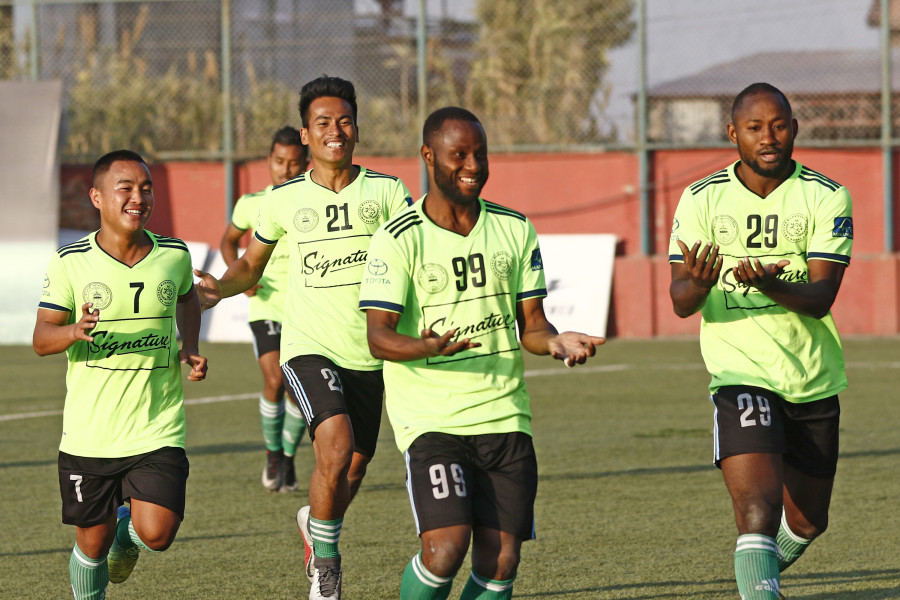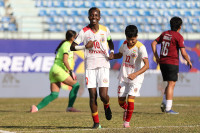Football
Once trafficked to Nepal, African footballers now come willingly to play the beautiful game
Nepal offers better pay, decent competition and a stepping stone to greener pastures, say African players
Prajwal Oli
Azeez Saheed is arguably Manang Marshyangdi’s best central defender. The 26-year-old Nigerian’s ability to go on overlap and even score goals has set him apart from the rest of his teammates. At 5 feet 8 inches, Saheed is equally efficient with either foot, but he obviously has a bullet of a shot off his right foot.
Saheed came to play football for Manang Marshyangdi Club in April, hired for a three-month stint as a star addition to the club’s defensive line-up for the group stage of the AFC Cup, the Asian Football Confederation’s second-tier club football competition, the group stage of which will run until June 26.
For his three months at Manang Marshyangdi, Saheed was paid $3,500, a significant sum for football players in Nepal. And unlike many other African players in Nepal, Saheed came here willingly. Nepal is now a gateway to greener pastures and better leagues in other countries, he said. This is a sentiment that is shared by more and more African players, who were once hoodwinked into coming here, but now come out of choice—for better pay, decent competition and a stepping stone to elsewhere.
"Nepal is a place to grow and improve my game,” said Saheed. “This applies not just to foreign recruits like me, but also for locals. Talented players like Rohit Chand and Kiran Chemjong are playing abroad and making a real mark.”
Saheed first came to Nepal during the 2013-14 football season on the advice of his friend Sulaiman Olansile Wasiu, who was then playing for New Road Team. Saheed too joined New Road and played in Nepal’s top-tier Martyrs’ Memorial League. After playing for Manang the following season, he plied his trade for the next four seasons in Yemen, Hungary and Bahrain before returning to Manang this season.
He came back to Nepal because the AFC Cup is watched all over the continent, he said, and he believes that he could get a better offer if he catches the attention of rich Middle Eastern countries like Bahrain, Qatar and Saudi Arabia.
But things weren’t always so bright for African footballers in Nepal. Players from countries like Nigeria, Cameroon, Guinea and Ivory Coast have been playing for Nepali clubs since the 2006-07 season, when there were five players, from Tanzania, Nigeria and Ivory Coast, who came to Nepal illegally through India in search of better options.
"As paperwork and documentation is easier to obtain in Nepal, they were legalised by football clubs after being hired,” said Sanjib Mishra, director of the Martyrs Memorial League and former development director of the All Nepal Football Association (ANFA). “There is no official channel to enter Nepal through an agent as there are no authorised players' agents in the country.”
Some players were even trafficked to Nepal, lured by unscrupulous agents promising to take them to Europe, particularly Naples in Italy. Abandoned in Kathmandu with few options, they turned to doing what they knew best—playing football.
But it was in 2007 that Nepali clubs began to actively hire African players. ANFA had increased the prize money for the domestic league, justifying Nepali investment in players from other countries.
“Football is a game of power and it requires energy and speed,” said Meghraj KC, Three Star Club coach. “African players have a stronger physique than Nepali footballers. They are also fearless in the game. That is the major reason that African players have become a major attraction in Nepali football."
As per ANFA regulations, a team can only field three foreign players in the playing set. By 2010, the number of African players in Nepali clubs had reached 12. But this number saw a dramatic rise in 2011, when all the clubs, except for three departmental teams—Nepal Police Club, Tribhuvan Army Club and Nepal Armed Police Force Club—met the foreign player quota. In the 2011-12 season, there were 36 African players playing in Nepal’s 'A' Division league.
Among them was Manang Marshyangdi’s influential Nigerian forward Afeez Olawale, who came to Nepal through one of his African friends. The 24-year-old’s dribbling skills, ball control and the ability to make snap decisions quickly made him one of the highest scorers in the league.
After he arrived in 2012, he was suspended for a year from Nepali football for manhandling a Tribhuvan Army Club player, but in 2015, returned to play for Three Star Club. The following year, he switched to Manang Marshyangdi and since 2018, after a stint in Bangladesh, has become one of Manang’s star players, leading the club to ‘A’ Division league victory last season by scoring seven goals in the season.
And in a reversal of fortunes from the early arrivals from Africa, Olawale was making around $1,800 a month, becoming the highest paid player in Nepali football.
"Finances are what is driving Africans to play in Nepal,” said Olawale. “And if you are good enough for Nepali football, you are guaranteed to be featured in the top-tier league."
Olawale only plays in Nepal when he doesn’t have better offers from other countries, he said. During his one season in the 2017 Bangladesh Premier League, he was paid around $4,000 a month, four times what he was offered by Manang in 2016, he said.
An African player earns an average salary of $800 per month during the Martyrs Memorial 'A' Division League, which is equivalent to around Rs90,000. In comparison, the average salary of Nepali players is Rs30,000 for the same tournament. While Olawale, the highest paid African makes $1,800 (around Rs200,400) per month, the highest earning national players—Nepali internationals like Three Star defender Ananta Tamang and Manang winger Anjan Bista—earn around Rs90,000, the maximum for locals.
Of the 33 foreign players in the league last season, 31 were from six African countries—Mali, Nigeria, Ivory Coast, Cameroon, Guinea and Zimbabwe. Except for a few exceptional players like Olawale, most Africans are of a similar level as Nepalis in terms of performance. So why are they paid more?
"African players don’t need to be paid round the year like Nepali players,” said Indra Man Tuladhar, president of Sankata Club, who is also ANFA general secretary. “Most often, they are hired for two or three months, just to play the league. Many are drafted in to save the team from relegation."
Sankata had three Cameroonian players last season and the unfancied team surprisingly finished as runners-up. Though the foreign recruits were average performers, they balanced the team and elevated confidence levels.
"If you do the calculations, African players are cheaper than Nepali players and they give it their all during games," he said.
Even African players who aren’t as good as Nepalis are drafted because they cost relatively less in the long term. But there is also pressure from fans. “It is not just fans. Even board members ask why we don’t have any African players on the squad,” he said.
Since almost every team in the A Division league fields African players, it has become a compulsion to include them, even just for the psychological boost.
Five African countries, whose citizens played in the Nepali league last season, are placed between 42 to 68 in the FIFA world rankings, compared to Nepal’s position at 161. But they still choose to play in Nepal because of their relative dominance in the game.
"There are lots of talented players in Nigeria so it is difficult to get a chance to play professional football there," said Olawale. Only three or four of the Africans playing in Nepal have played professional football in their home countries, he said.
The footballers who end up in Nepal never belonged to the top echelons in their own countries, said Sugan Tandukar, who coordinates African hires for Nepali clubs. Around 70 players from various African nations came to Nepal last season, but only 31 got a chance to play in the league.
"Most players who come to Nepal either play second division or third division leagues in their countries," said Tandukar.
While they don’t qualify for top-tier leagues in their own country, in Nepal, they’re among the best, he said, prompting many to seek to better their game here.
Earlier this year, little-known Cameroonian outfit Dauphins Family won six Nepali knockout football tournament titles in four months after arriving in January. Three of their players have already been signed by Nepali clubs for upcoming 'A' Division league.
And though it might sound incongruous, the pay is better in Nepal. The average top division player in Cameroon earns an average wage of 100,000 FCFA per month, which is equivalent to Rs18,000, says Tandukar.
“As far as I am aware, wages for non-elite footballers in many other African countries are somewhat similar,” he said. “The average wage of the African player in Nepal ranges from $800 to $1,000 (Rs89,000 to Rs111,260). Even the lowest earner gets $400 (Rs44,504)."
And for Nepalis, getting to play alongside African players is a learning experience.
“I have found many African players to be short tempered but Olawale is friendly and just like any other Nepali teammate," said Bishal Rai, Manang midfielder and Olawale’s teammate. “We get an opportunity to learn a lot from them.”




 16.12°C Kathmandu
16.12°C Kathmandu















